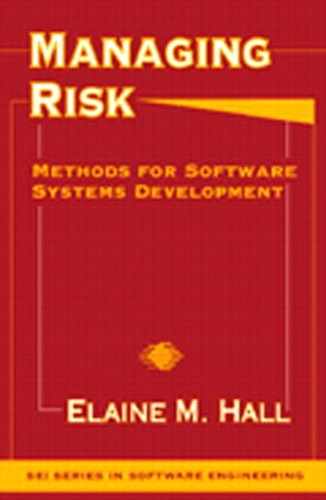Epilogue
Managing Risk: Methods for Software Systems Development introduces three new methods to promote understanding of software risk management: the 6-D Model, the P2I2 Success Formula, and the Risk Management Map. The 6-D Model extends the Deming PDCA cycle by adding the ability to reveal risk and opportunity. Conceptually more powerful than a Turing machine, the 6-D Model is a requisite set of properly coordinated disciplines because it describes the four quadrants of human awareness. The ability to perceive risk exists in our right brain, where there is no faculty for processing speech. Perhaps that is why we often make decisions based on a few facts loaded with emotion. The P2I2 Success Formula is a cause-effect diagram that relates the factors influencing risk management capability. We can distribute the task of managing risk according to four major factors: people, process, infrastructure, and implementation. Using this divide-and-conquer approach, parallel efforts can speed the adoption of risk management within an organization. The Risk Management Map synchronizes these efforts by providing direction through five evolutionary stages: problem, mitigation, prevention, anticipation, and opportunity. To achieve the next stage of our development on the road from novice to expert, we need the vision, goals, and strategy provided by the map. Risk management capability increases through the accomplishment of each goal, which enhances the ability to manage risk.
Risk management is not the grail of the software community. However, the search to understand how risk fits into the big picture of managing software development led to its discovery. The grail was found within each one of us, it is the essence of what makes us human. Should we be surprised to find a tree when looking at the forest? No. We should expect that an effective approach to thinking, created by millions of years of evolution, would scale from individuals to teams, projects, organizations, the software community, and beyond. Feeding the grail (i.e., reading this book) will not resolve your risks. Results come only from application of knowledge and development of skills through practice. To obtain the results we desire as a software community, we must use the grail to resolve our prioritized risks, for that is where the opportunity lies.
This book is about results from application of risk management methods in software systems development. The opportunity-stage project is an example of a project with excellent risk management results. To achieve these results, the project team worked hard. Risk management does not make difficult work go away. The project is not intended to serve as an example of the best risk management process, because the best process is the one that is tailored for a custom fit. Ultimately, results matter more than process. The project quantified ROI(RM) at 22 to 1. That is risk management nirvana.
Let us briefly recap the important conclusions offered in Managing Risk:
1. Risk identification is a right-brain activity. Effective methods and tools to identify risk will allow for the specialized way the right brain processes information.
2. The grail is our brain. The meaning of life and perception of risk, housed within the grail, is different for each person. The productivity of any organization is based on individual performance. Performance is relative to perceived importance.
3. Results matter more than process. The product is a measure of process value. Users, not process, measure product value. The process is never more important than the product. The product is never more important than the user. This is the engineering food chain.
4. The benchmark for ROI (RM) is over 20 to 1. A best-in-class standard for risk management return on investment is over 20 to 1. Working to achieve this benchmark will maximize opportunities within an organization.
5. Negative thinking is positive. Positive results prove that negative thinking is positive. This paradox destroys the illusion that the best results come only through positive thinking. Managing risk is negative thinking that has positive results.
